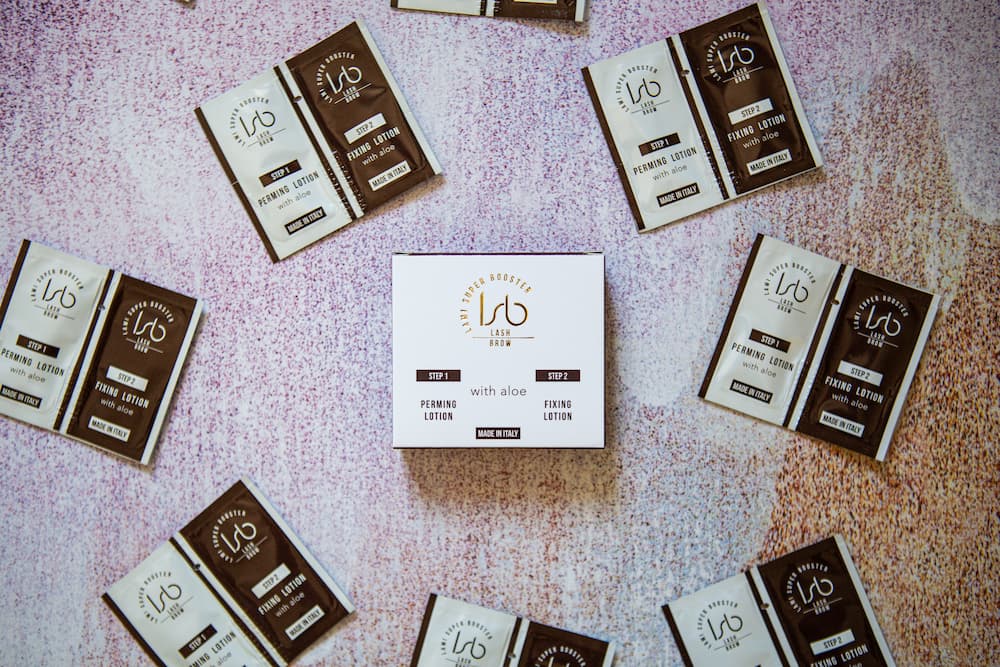Chemical Composition and Mechanism
Lash lift lotions primarily work through active ingredients that alter the hair structure by breaking disulfide bonds in the lash cortex. The main active ingredients typically include:
- Ammonium Thioglycolate
- Thioglycolic Acid
- Cysteamine HCL
- Supporting ingredients like Cetearyl Alcohol and Glycerin
These compounds operate within a specific pH range of 8.1-9.5, which is necessary for effectively breaking down keratin bonds. This chemical process allows for the restructuring of the lash shape while maintaining structural integrity when properly applied. The pH level is crucial for the effectiveness of the treatment; for instance, the initial lifting lotion often has a pH of around 8.7%, while the fixing lotion typically has a lower pH range of 2.4-2.6%.
It’s important to note that the choice between Ammonium Thioglycolate and Cysteamine HCL-based formulations depends on the specific needs of the client and the desired outcome. Neither is inherently superior, and both have their place in professional lash lifting procedures. For example, our product range offers options with both ingredients to cater to various client needs and technician preferences.
Understanding Aggressive vs. Gentle Formulations
The aggressiveness of a lifting lotion is determined by several factors:
-
Processing Speed: More aggressive formulations work faster but pose higher risks. These are often preferred by experienced technicians who can closely monitor the process.
-
pH Levels: Higher pH levels indicate more aggressive formulations. While these can provide more dramatic results, they also require more careful application and timing.
-
Concentration of Active Ingredients: Higher concentrations work faster but require more precise timing. This is where professional expertise becomes crucial.
-
Presence of Buffering Agents: Gentler formulations often include ingredients that help buffer the effects of the active ingredients, reducing the risk of irritation.
When selecting between aggressive and gentle formulations, consider the client’s lash type, previous lash treatments, and any sensitivity issues. For instance, clients with fine or previously treated lashes might benefit from a gentler formulation, while those with coarse, resistant lashes might require a more aggressive approach.
Safety Considerations and Risk Management
Potential Risks
- Chemical burns or irritation, particularly if the product comes into contact with the skin or eyes
- Over-processing leading to brittleness or temporary lash loss
- Allergic reactions, which can range from mild irritation to severe swelling
- Eye irritation if product enters eyes, potentially causing corneal abrasions or ulcers
Professional Safety Protocols
- Always perform patch tests 48 hours before treatment to identify potential allergic reactions
- Use precise measurements for application to avoid over-application
- Monitor processing times carefully, using a timer for accuracy
- Keep detailed client records, including product used and processing times
- Use appropriate protection for both technician and client
- Ensure proper ventilation in the treatment area to minimize inhalation of fumes
Implementing these safety measures is not just about preventing immediate adverse reactions; it’s also about maintaining the long-term health of your clients’ lashes and building trust in your professional services.
Signs of Over-Processing
Watch for these warning signs:
- Excessive curl or frizzing, which can indicate that the bonds have been over-manipulated
- Brittle or breaking lashes, a sign that the lash structure has been compromised
- Uneven lift results, possibly due to inconsistent application or processing times
- Client discomfort during processing, which could indicate irritation or an allergic reaction
If you notice any of these signs, it’s crucial to act quickly. Remove the product immediately and apply a neutralizing solution if necessary. Document the incident and adjust your technique or product selection for future treatments.
Best Practices for Application
-
Preparation:
- Clean lashes thoroughly to remove all oils and residues that could interfere with the lifting process
- Remove all makeup and oils using a gentle, oil-free cleanser
- Perform a patch test if it’s a first-time client or if you’re using a new product
-
Application Technique:
- Apply perming lotion evenly
- Use a micro-brush for precise application, ensuring even coverage
- Monitor processing time precisely, using a timer to avoid over-processing
- Maintain proper room temperature and humidity, as these factors can affect processing time
-
Aftercare:
- Provide clear, written aftercare instructions to clients
- Recommend appropriate aftercare products, such as lash serums or gentle cleansers
- Schedule follow-up appointments to monitor lash health and maintain results
Remember, the key to successful lash lifting lies in the details. Precise application, careful timing, and attentive monitoring throughout the process are essential for achieving optimal results while minimizing risks.
Professional Product Selection
When choosing lifting lotions, consider:
- Client’s lash type and condition (fine, coarse, previously treated, etc.)
- Processing time requirements based on your salon’s scheduling needs
- Safety certifications and compliance with local regulations
- Manufacturing standards and ingredient quality
For professional results, explore our range of brow lamination products which maintain consistent quality and safety standards. These products are formulated to provide effective results while prioritizing lash health and safety.
Maintenance and Storage
Proper storage ensures product efficacy and longevity:
- Store in a cool, dry place away from direct sunlight
- Keep containers tightly sealed to prevent contamination and evaporation
- Check expiration dates regularly and dispose of expired products
- Maintain proper temperature control, avoiding extreme heat or cold
Additionally, it’s crucial to regularly clean and sanitize all tools and equipment used in the lash lifting process. This not only ensures hygiene but also prevents cross-contamination between clients.
Remember, professional-grade products require professional knowledge and application. Continuous education and adherence to safety protocols are essential for optimal results and client satisfaction. Stay updated on the latest techniques and product developments to provide the best possible service to your clients.
By understanding the chemistry behind lash lifting lotions and implementing strict safety protocols, you can offer effective, safe treatments that keep your clients coming back for more. Always prioritize lash health and client safety above all else, and you’ll build a reputation as a trusted lash professional.
